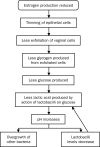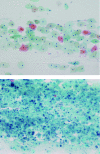Vulvovaginal atrophy
- PMID: 20042564
- PMCID: PMC2800285
- DOI: 10.4065/mcp.2009.0413
Vulvovaginal atrophy
Abstract
Vulvovaginal atrophy (VVA) is a common and underreported condition associated with decreased estrogenization of the vaginal tissue. Symptoms include dryness, irritation, soreness, and dyspareunia with urinary frequency, urgency, and urge incontinence. It can occur at any time in a woman's life cycle, although more commonly in the postmenopausal phase, during which the prevalence is close to 50%. Clinical findings include the presence of pale and dry vulvovaginal mucosa with petechiae. Vaginal rugae disappear, and the cervix may become flush with the vaginal wall. A vaginal pH of 4.6 or more supports the diagnosis of VVA. Even while taking systemic estrogen, 10% to 20% of women may still have residual VVA symptoms. Breast cancer treatment increases the prevalence of VVA because the surgical, endocrine, and chemotherapeutic agents used in its treatment can cause or exacerbate VVA. Local estrogen treatment for this group of women remains controversial.
Figures
References
-
- Moreira ED, Glasser DB, Nicolosi A, Nicolosi A, Duarte FG, Gingell C, GSSAB Investigators' Group Sexual problems and help-seeking behavior in adults in the United Kingdom and continental Europe. BJU Int 2008;101(8):1005-1011 - PubMed
-
- Simon JA, Komi J. Postmenopausal women's attitudes: vulvovaginal atrophy and its symptoms [abstract LB-10]. Menopause 2007;14(6):1107
-
- Iosif CS, Bekassy Z. Prevalence of genito-urinary symptoms in the late menopause. Acta Obstet Gynecol Scand 1984;63(3):257-260 - PubMed
-
- Dennerstein L, Dudley E, Hopper JL, Guthrie JR, Burger HG. A prospective population-based study of menopausal symptoms. Obst Gynecol. 2000;96(3):351-358 - PubMed
-
- Stadberg E, Mattsson LA, Milsom I. The prevalence and severity of climacteric symptoms and the use of different treatment regimens in a Swedish population. Acta Obstet Gynecol Scand 1997;76(5):442-448 - PubMed
Publication types
MeSH terms
LinkOut - more resources
Full Text Sources
Other Literature Sources
Medical



